The tree of plenty
Beechnuts are genuine calorie bombs for bears
Promise is in the air in the central Apennines. After several years of waiting, the beech trees bloom in spring and as early as late July, the branches are bending under the weight of the unripe fruits.
A single tree can produce more than 30,000 fruits (beechnuts) in one growing season. A real bonanza for hundreds of animal species, providing the fruits are able to ripen, something that occurs in just a few very special years. But in these years, it is in autumn that the forests are especially full of life. The tree branches are targeted by birds such as tits and finches, together with rodents, including dormice and squirrels that hoard the fruits. Ripe beechnuts fall to the ground by gravity, helped by the numerous visitors and gusts of autumn wind. The forest litter is covered with thousands of spiny leathery cupulas and crunches under the weight of wild boar and red and roe deer as they dig deep with their noses in search of food. But there is also turmoil below ground. Industrious voles transport the beechnuts to their burrows where they hoard them to guarantee a reserve of food for the winter and following spring. Bears are obviously not indifferent to this bonanza.
The invisible eye of a remote video camera placed in a remote forest reveals the movements of bears and wild boars in search of beech masts in the early winter.
The autumn of 2007 was an extraordinary bumper year in the Park. As early as the first week of October, the bears seemed to have fixed a date to meet up. Within a few weeks, two adult females, F07 and F06, and a young male, M09, had taken up position in the same valley in one of the most verdant forests in the heart of the Park. When beechnuts are very abundant, individuals can feed for long periods in even very small areas without ever leaving them. By using radio telemetry, we discovered that some bears frequented areas smaller than half a square kilometre for almost a week.
Elisabetta
Tons of calories
The fruit of the beech tree, the beechnut, consists of a leathery husk known as a cupula containing two achenes, woody semi-triangular seeds rich in sugars and abundant oils. Each beechnut corresponds to about 2 kilocalories. In a bumper year, a forest can produce an average of 246 kg of beechnuts per hectare, so each hectare of forest can contain up to 500,000 kcal. Considering that in the Park there are about 24,455 ha of beech forests, they can produce more than 6,000 tons of beechnuts in a single year. Compared to other fleshy fruits (such as apples or pears), beechnuts are richer not only in fats (18.4%) but also proteins (14.6%) and minerals. With just this one type of food, bears can put on weight quickly with almost no effort. This high-calorie, nutritious food allows females to complete their pregnancy, then deliver and nurse their young.
In autumn when the fruits are fully ripe and “raining” down onto the ground, the bears spend their days ploughing up the ground like wild boars. In years when beechnuts are scarce, the competition with birds, rodents and wild boars is so high that the bears adopt another strategy… they climb the trees and pick the nuts directly from the branches. After a bumper autumn, the seeds are first hidden among the dead leaves in the litter, then covered by the winter snow where they await spring, as do the bears in their dens. From April to June, the beechnuts that have managed for months to resist the attack of mould, bacteria, insects and even birds and mammals become an exceptional nutrient supplement in the bears’ diet. The animals use their refined sense of smell and acute hearing to dig through the leaves and rummage in the stores of small rodents. Although red deer and wild boar are present in large numbers in the Park, in bumper years, bears can still find abundant acorns and beechnuts even in spring. In short: there’s enough for everyone.
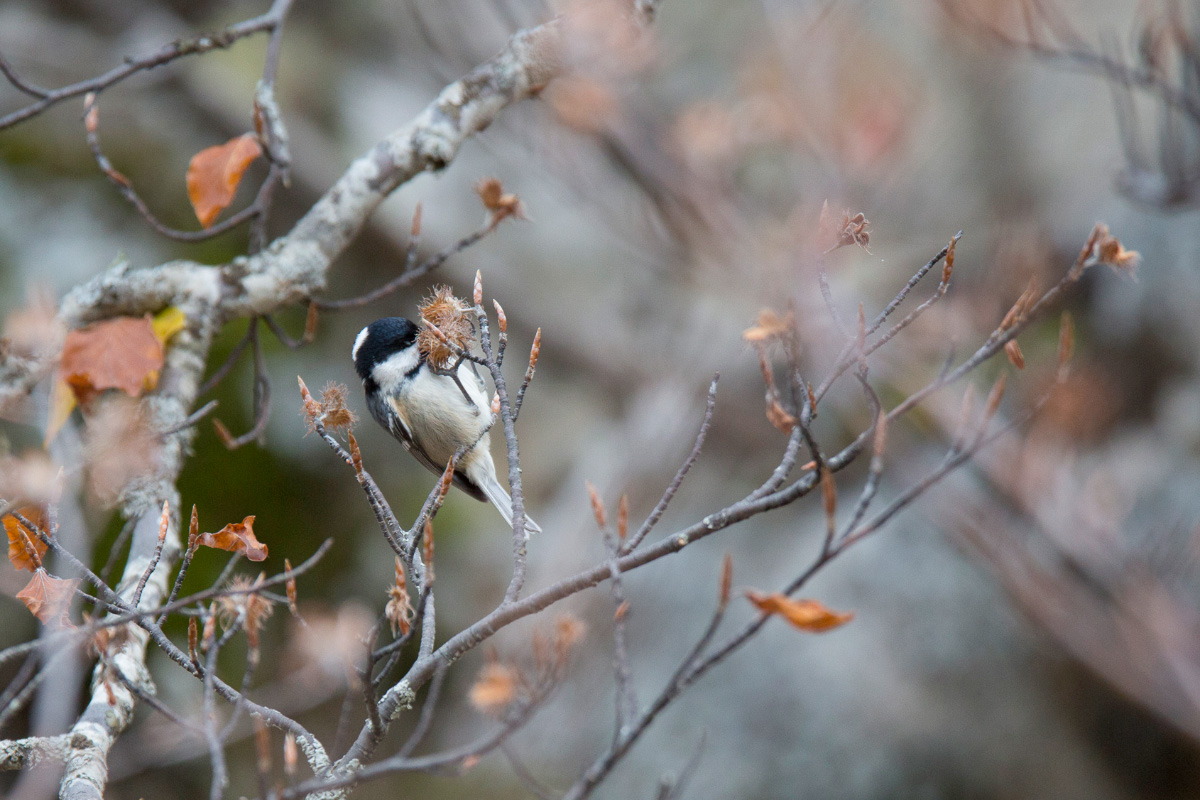
A coal tit pecks at a beech mast still attached to the tree. In the Apennines it is not only bears that take advantage of the years of grazing, but dozens of different species.
It was 14 December 2007. Three of the bears we were tracking had been in the same area for weeks. We used telemetry to make sure the bears were far away, then entered the forest, trying to overlap our steps to avoid making a noise. I remember it was a very windy day and probably the thudding of the beechnuts on the ground muffled the sound of our footsteps, because a few dozen metres away from us, a bear was calmly circling around the base of the trees, to then move on in a straight line again, slowly, a few metres a minute. His nose was almost always to the ground, although he raised his head from time to time to listen and look around. He ate like a true gentleman. He grasped the beechnuts gently with his lips, chewed the cupula and let it fall from the side of his mouth, then swallowed the seeds. The fascinating thing was that as he moved, he lingered on each paw with his full weight, almost as though wanting to leave a cast of each foot in the litter. This is how a bear marks and signals its passage to other bears. A way of avoiding stepping on each other’s toes too much.
Elisabetta
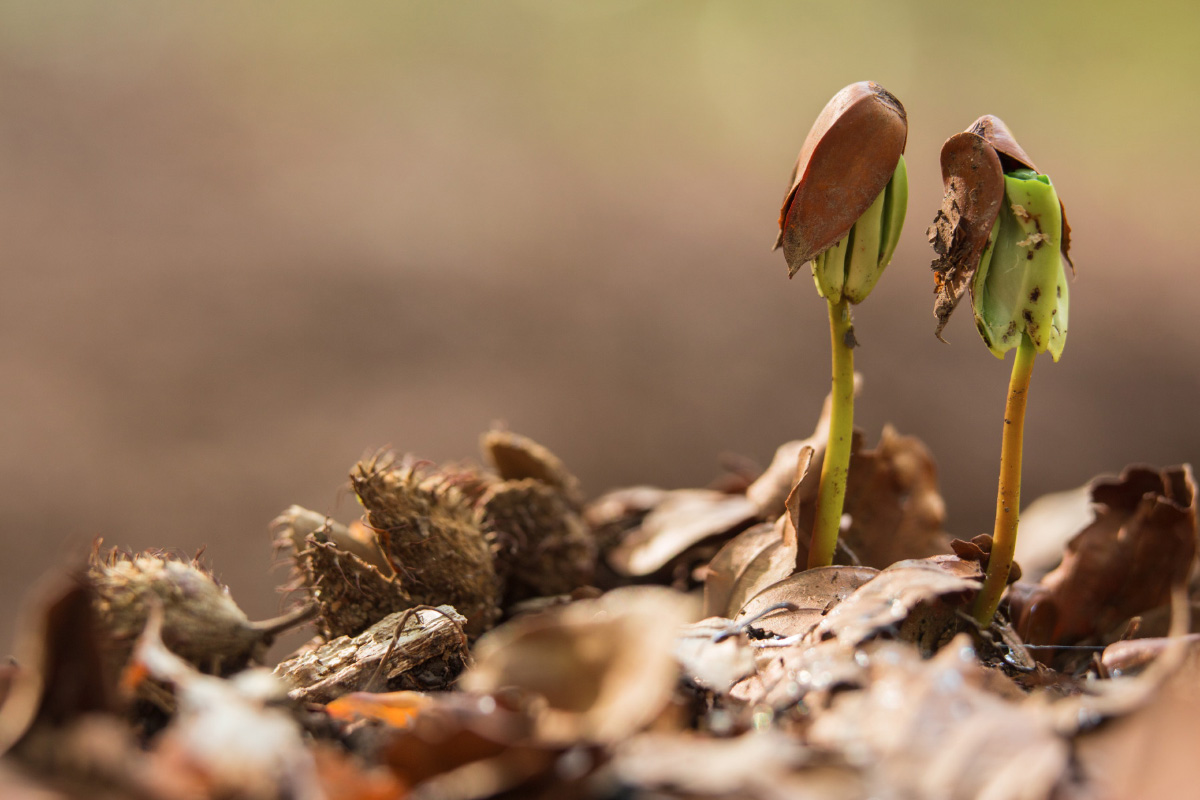
The bud of a young beech tree. After the winter, millions of beech masts cover the ground and the trees of the future grow from those that have survived fungi, mould and animals.
The presence of large quantities of beechnuts controls both the bears’ movements and their winter metabolism. For example, in bumper years, some bears not only enter the den later, but also sleep less. These extra months of feeding benefit mainly the bears that need the most energy, two-year-olds and females with cubs. In the winter of 2006-2007, the young bear M09 never entered a den, while the female F06 interrupted her long sleep for an exploratory beechnut supply trip.
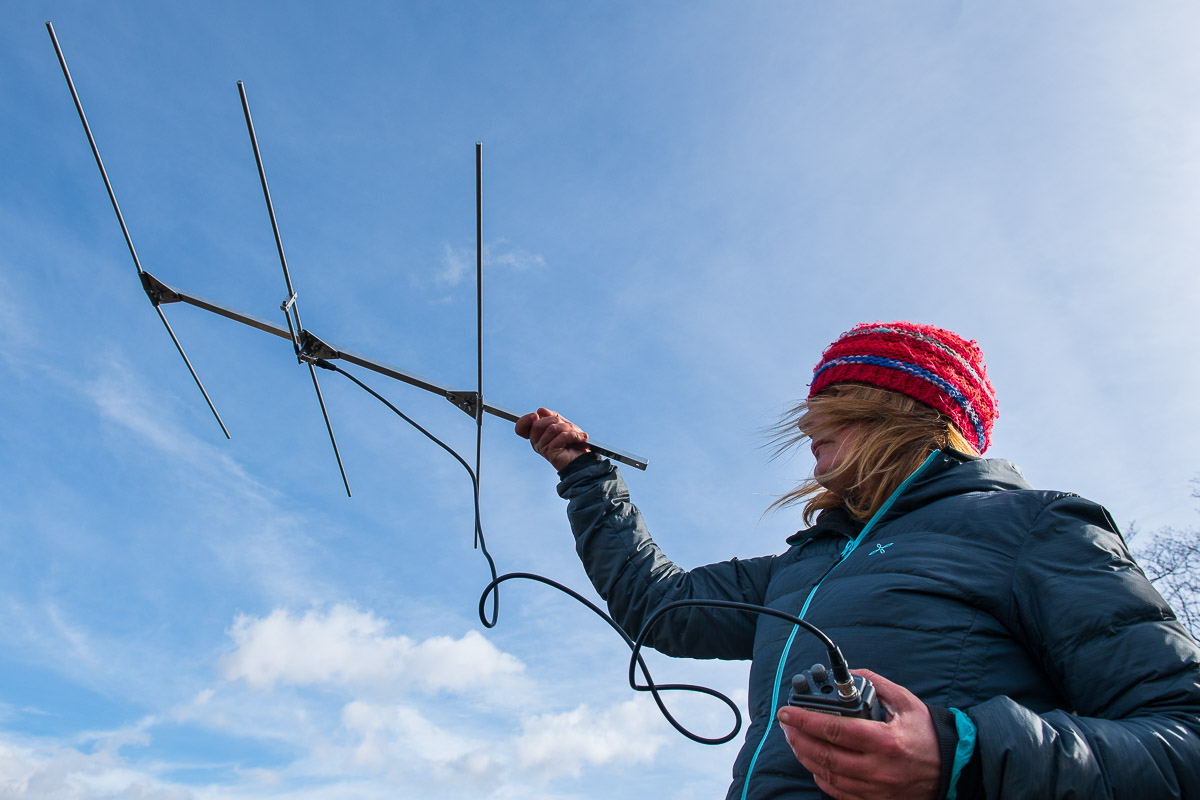
A researcher holds a telemetry antenna to follow the movements of a radio collared bear from a distance. This technique is essential for understanding the behavior of these animals during the beech mast season.
It was 25 February 2007 when we detected the collar signal of bear F06 in a different direction than usual. We used to walk through the valley every other day to check and verify from a distance that the bear was in her den. This wasn’t the first time I’d walked through that valley in winter. But that year the valley was different. The snow was a complete mess. The valley was criss-crossed by hundreds of wild boar and red deer tracks and there were signs of digging everywhere. F06 had left her den, while the young male M09 had never even entered it. The snow was about 40-50 cm high, but in some places it was as much as a metre deep. I followed the bear’s tracks down a steep slope and through a series of dolines, then abandoned them as they entered a new valley. Along the entire 5 km route, the bear had stopped several times, repeatedly plunging her nose into the snow for about ten centimetres, digging circular holes each time. At one point she had even dug herself a bed under a rotten log, probably to rest. She remained active in the adjacent valley for about seven days, then returned to the original den area until the first week of April.
Elisabetta
The first snow show the passage of a family of bears through a beech forest. With the arrival of winter, in the mast years, the activity of these animals is highly concentrated in the forests.
But beechnuts give bears genuine “power”. From 2004 to 2019, bears had to wait for a bumper crop for from two to as many as five years. In the years after a bumper year, technicians and researchers have confirmed that more females become mothers, as is also the case, for example, with black bears. But the rule does not always apply. Despite the scarce production of beechnuts observed from 2015 to 2018, the number of births in fact remained high, an indication that even in these years, the female bears found plenty of food, including acorns (turkey and downy oak) and other fruits that ripen in summer and autumn. For bears, the extraordinary nature of the Apennines is precisely this abundant supply of nuts and fleshy fruits and protecting them can help guarantee the survival of this adaptable animal.
L’esperto di orsi americano David Mattson ci spiega l’importanza dei frutti secchi, in generale, come risorsa alimentare per gli orsi e la dipendenza degli orsi grizzly per i semi di pino cembro e il ruolo che gli scoiattoli rossi svolgono nel trasferire i semi dagli alberi all’orso.
In some years, each beech tree produces more flowers than in previous years and this is true for all, or almost all, the trees in the population, a phenomenon that usually occurs at intervals of from 2 to 10 years. The synchronisation enables the wind-pollinated plants to maximise the probability of regeneration. But this only happens in certain weather and climate conditions. If a cold, wet summer is followed by a hot, dry summer, the following year, the beech trees stop growing to reproduce, in other words, to flower, provided the spring has been mild. Plants over thirty years old usually produce the most fruits. After profuse flowering, the trees rarely have sufficient energy to flower abundantly again the following year. Hence the periodicity with which the flowers (and consequently the fruits) are produced. But what can cause a bumper year to fail? Heavy rainfall and spring frosts can inhibit pollen formation, pollination and thus the formation of fruits, just as severe summer drought can cause the fruits to abort, even if pollination has taken place. This sensitivity to drought makes the beech tree very susceptible to climate change, more so than oaks.
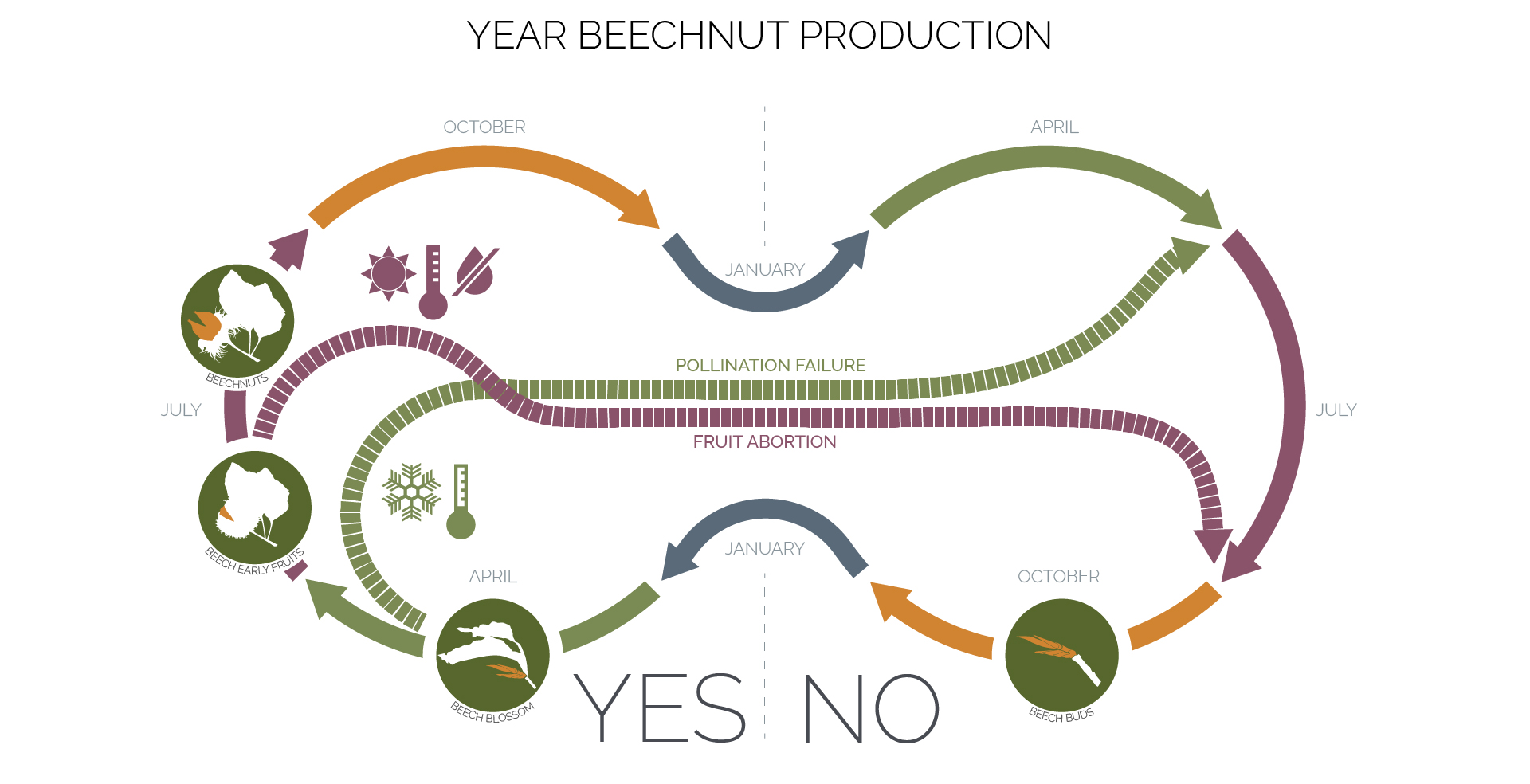
Especially in summer and autumn, bears can consume up to 20,000 kilocalories and when possible, they use every hour in the day to find food. Beech forests cover more than half the protected area in the heart of the Park and bears can find not only food there, but also safety and tranquillity. At lower altitudes of around 1,000 to 2,000 metres, the beech forests give way to oak woods: hundreds of square kilometres of turkey and downy oak woodland with highly nutritious acorns, very appetising for bears in autumn. For example, almost every year a turkey oak forest can produce an average of more than 500 kg of acorns in a thousand square metres. But in some years, acorn production may be more abundant than usual… even oaks have their bumper years and this inevitably attracts bears to less safe and less tranquil areas.
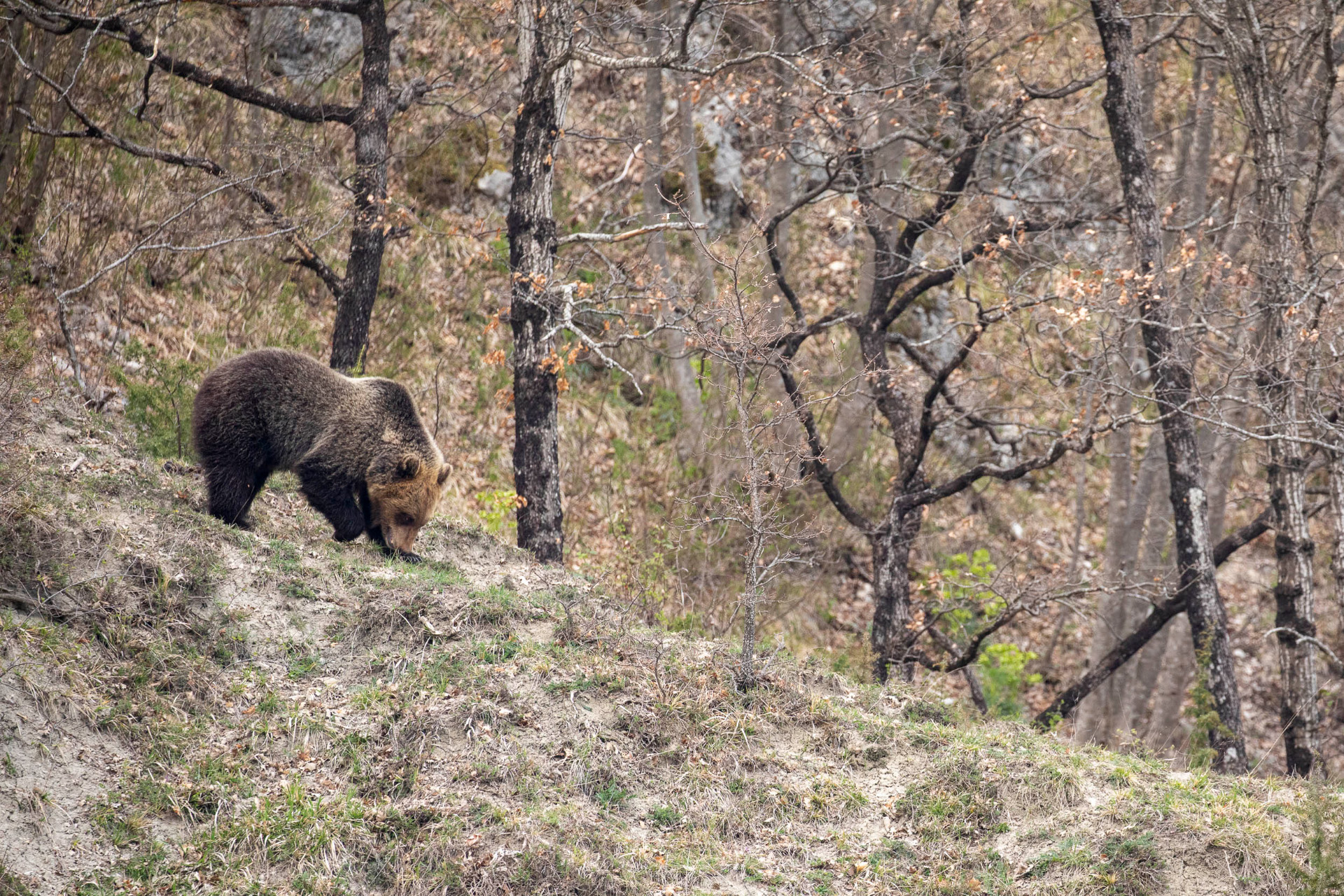
At the end of winter, a bear feeds on acorns that have fallen to the ground. Compared to beechnuts, the fruit of the oak tree is a more widespread and accessible food resource.
Outside protected areas, uncontrolled use of the land in beech forests and oak woods during the autumn for recreation and productive purposes may prevent bears from feeding adequately in a very critical season. Protecting them also depends on our daily choices.

